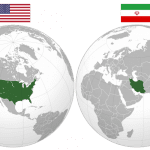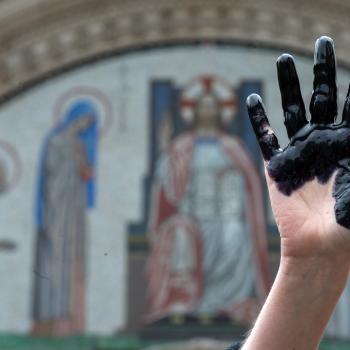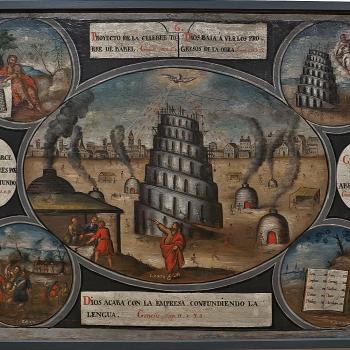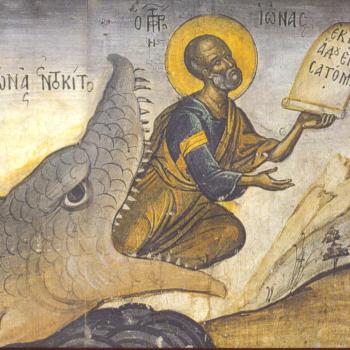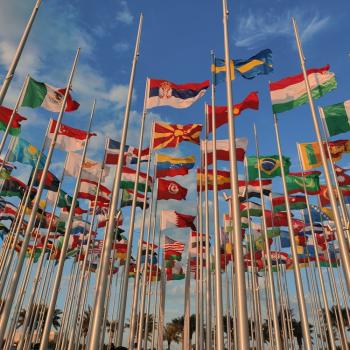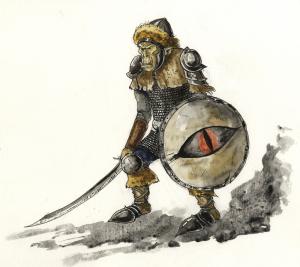
Many fans of J.R.R. Tolkien like to use his works to promote war. Others, likewise, like to use his works as a defense of racism. The first group suggests that the works of Tolkien are filled with war, showing the good which can come out of it, forgetting, however, the ultimate solution for Tolkien was not war, and the embrace of power which is required in war to be a “victor,” but the destruction of the Ring, and the rejection of all ideologies of power. Those of the second group like to use Orcs as a metaphor, representing all the races and culture they want to destroy, forgetting that Tolkien wanted it to be understood that the Orcs represented the corruption that can take place and destroy anyone from any race or culture. The Orcs, then, can be found anywhere, and indeed, are found everywhere. The way some of the so-called “ultra-right” or “alt-right” try to use and employ motifs from Tolkien’s works do so in a way to corrupt them, indeed, overturning the insights which inspired Tolkien to write his stories.
Thus, while Tolkien firmly rejected the evils which came out of Nazi Germany, horrified by the way Hitler had used and abused the “noble northern spirit” with a demonic perversion of it,[1] he was also concerned with the way the Allies in World War II were embracing the same perversions so that in the future, they would risk becoming that which they fought against. That is, he saw many were embracing the will to power and domination, the power of the Ring, while others were promoting and spreading terrible ideologies which turned people into “Orcs.” Using parallels from his own stories, Tolkien explained his fear to his son, Christopher:
However it is, humans being what they are, quite inevitable, and the only cure (short of universal Conversion) is not to have wars – nor planning, nor organizations, nor regimentation. Your service is, of course, as anybody with any intelligence and ears and eyes knows, a very bad one, living on the repute of a few gallant men, and you are probably in a particularly bad corner of it. But all Big Things planned in a big way feel like that to the toad under the harrow, though on a general view they do function and do their job. An ultimately evil job. For we are attempting to conquer Sauron with the Ring. And we shall (it seems) succeed. But the penalty is, as you will know, to breed new Saurons, and slowly turn Men and Elves into Orcs. Not that in real life things are as clear cut as in a story, and we started out with a great many Orcs on our side …[2]
Despite what some of his fans might suggest, Tolkien understood the horrors of war. While he did not object to the notion of a just defense, he was against any militant notions such as a pre-emptive strike as being justified. He thought that the solution to war was not more war, or plans for more wars, but rather, to go beyond the logic of war itself. War begets war; preparing for war leads to people to accept the unacceptable, to use “the Ring” in order to achieve an easy victory, only to find themselves becoming Dark Lords themselves. As the Orcs were created by corruption, that is, they must not be seen as a race which developed on its own, Tolkien understood that with a new Dark Lord there would be more Orcs, that is, more corrupted people who would follow the ideologies of that new Dark Lord. Racism, nationalism, fearmongering, hatred, selfishness, and the rejection of the common good, all of these are a part of the corruption which creates an Orc, the willing slave of a Dark Lord.
Tolkien was concerned with what the Allies were willing to use in order to achieve victory. He knew and saw firsthand the corruption of the will to power, and with it, a willingness to use whatever force one could attain as a means of destroying others. While Tolkien was clear that the Ring was not an allegory of the Atomic Bomb, because he wrote of the Ring long before the bomb was created and used, it is clear Tolkien saw in it a darkness which was similar to the power of the Ring itself:
The news today about ‘Atomic bombs’ is so horrifying one is stunned. The utter folly of these lunatic physicists to consent to do such work for war-purposes: calmly plotting the destruction of the world! Such explosives in men’s hands, while their moral and intellectual status is declining, is about as useful as giving out firearms to all inmates of a gaol and then saying that you hope ‘this will ensure peace.’[3]
While we must avoid any suggestion that the Ring was meant as an allegory of the Atomic Bomb, it is not wrong to see Tolkien’s understanding of the power and destruction possible with the Ring to be something contained within Atomic weaponry. Those who possess such weaponry face the same corruption and power as those who possess the Ring. The Ring is not an allegory of the bomb, it is something deeper, because Tolkien’s literary analysis transcends the bomb. Tolkien’s presentation of the way the Ring corrupts its users points out the way any such evil, any attempt to create a force of power and domination of others, will corrupt those who employ their use. Even when some good is intended, the corruption will be there. For this reason, although the Ring is not an allegory of the bomb, it represents the same fundamental error which is had by those who produced and used the bomb, explaining how and why it could appear to be such an allegory.
With the rise of militant nationalism and alt-right leaders who engage nationalism for the sake of power, thus, with those embracing some form of the Ring, Tolkien’s words to his son appear prophetic. And just like Hitler once used the “northern spirit” with all its tales, tales which Tolkien himself had loved in his youth, to corrupt his people and turn them into Orcs, so we see many use other good tales, even Tolkien’s, are being used and abused to corrupt others. The same type of nationalistic pride and the same violent, xenophobic stand suggested by Hitler and other fascists of Tolkien’s day are on the rise once again. Tolkien, who was somewhat confused by the reaction to his work in the 1960s, would be disgusted with the way some are using his works to promote the rise of a new Dark Lord, a new Sauron. Instead of being used to glorify war, they should be used to exemplify the lesson Tolkien himself learned through his own military experience: war is hell, and in its wake, those who are said to be its victors lose much of themselves in the process. After World War I and II, Europe, indeed, the world was harmed because the common good was overturned:
I have just heard the news … Russians 60 miles from Berlin. It does look as if something decisive might happen soon. The appalling destruction and misery of this war mount hourly: destruction of what should be (indeed is) the common wealth of Europe, and the world, if mankind were not so besotted, wealth the loss of which will affect us all, victors or not. Yet people gloat to hear of the endless lines, 40 miles long, of miserable refugees, women and children pouring West, dying on the way. There seems no bowels of mercy or compassion, no imagination, left in this dark diabolic hour. [4]
Tolkien had a sense that humanity needed to come together, to embrace a way beyond the war of war. Europe, and the world, both had a common heritage and wealth which could be and should be shared by all, instead of some group or another thinking selfishly for their own interests alone. Pain and sorrow create more pain and sorrow: the victors of World War II had not learned the lesson of the war because they had begun to recreate the structures of sin which led to Hitler and his destructive march across Europe. Refugees, women and children, fleeing from war-torn sites should be given compassion and mercy, not ridicule and further abuse: the devilish temptation which had turned Hitler crazy could be seen finding a new host in the rest of Europe in the terrible reaction many Europeans had for such refugees. This evil ideology festered, and now has become a terrible outgrowth affecting not only Europe, but the rest of the world, with the treatment of the Trump administration with those seeking asylum representing one horrifying example of this evil.
Readers of Tolkien’s works should not be surprised about his perspective because it finds itself repeated several times in his works. Certainly, the need for people of different races, people of different lands, to overcome their differences and work together for the common good presents itself time and time again in his works.
In The Hobbit, dwarves, elves and humans had to overcome their histories of antagonism, mistrust, and greed, in over to come together and face the common enemy:
“Come!” called Gandalf. “There is yet time for council. Let Dain son of Nain come swiftly to us!”
So began a battle that none had expected; and it was called the Battle of Five Armies, and it was very terrible. Upon one side were the Goblins and the wild Wolves, and upon the other were Elves and Men and Dwarves.[5]
When people realize the trouble they face together, they need to come together, forgetting their rivalries if they want to succeed:
This is the plan that he made in council with the Elvenking, and with Bard; and with Dain, for the dwarf-lord now joined them: the Goblins were the foes of all, and at their coming all other quarrels were forgotten.[6]
What was true in The Hobbit was also true in The Lord of the Rings. The free peoples needed to come together, to join in the mission of Frodo to destroy the Ring. Only together, not apart, could they do what was necessary for success:
The Company of the Ring shall be Nine; and the Nine Walkers shall be set against the Nine Riders that are evil. With you and your faithful servant, Gandalf will go; for this shall be his great task, and maybe the end of his labours.
For the rest, they shall represent the other Free Peoples of the World: Elves, Dwarves, and Men. Legolas shall be for the Elves; and Gimli son of Glóin for the Dwarves. They are willing to go at least to the passes of the Mountains, and maybe beyond. For men you shall have Aragorn son of Arathorn, for the Ring of Isildur concerns him closely.[7]
Once again, only by coming together, and overcoming old prejudices, did the fellowship prove itself to transcend the ways of Sauron and have what it took to succeed in their mission. Perhaps no better representative of this is found in the Lord of the Rings than with the way Gimli was won over by Galadriel: the dark history between the dwarves and the elves, a history which included some of the way the elves treated the dwarves in The Hobbit finds itself overturned and healed by three golden strands of Galadriel’s hair.
And to those who would like to make some sort of separatist movement, promoting a particular ideology and trying to keep it pure and untouched from outsiders, Tolkien consistently wrote of the end result of such a wasted effort. This could be seen in the fall of Gondolin. Gondolin, to be sure, had started with a good objective and not the same ideology as many moderns wanting to retreat from world, fell because of its own attempt to keep to itself and hide itself from the world. Its destruction came from within as Maeglin, the king’s nephew, became an ally with Morgoth, the Dark Lord, and helped Morgoth in destroying Gondolin. In contrast to Gondolin, the elves at Rivendell never entirely cut themselves off from the rest of Middle Earth, and it was because of this Rivendell could become not only a true safe haven for those in need, but also a place of council where the plan to overturn Sauron’s hold on Middle Earth could be made. Indeed, Elrond was half-elven, demonstrating that great leadership and wisdom and authority came to him in part because he was able to take from the best of two different races and cultures, repudiating within his own being any notion of the superiority of “racial purity.”
Tolkien, far from a figure representative of the alt-right, or the ultra-right wing with their ideologies of power, warmongering, and xenophobia, was a writer who wrote against those ideologies, afraid of what their embrace would bring into the world. When he begun his sequel to The Lord of the Rings, The New Shadow, he saw, to his dismay, corruption was once again taking place in Middle Earth: kids were forming gangs, pretending to be Orcs, showing that Gondor had not learned its lesson from the fight against Sauron. It was too dire a story and Tolkien did not write much before giving up on his sequel and returning to his earlier tales, perfecting them throughout the rest of his life. But yet, it serves as a fine representation of the warning which he gave to Christopher: the people of the earth need not only to be victorious against the other, but they need to be victorious in a way that overturns the ideology of the other lest they become that which they fight against and doom themselves to repeat the evils of the past. The rise of the alt-right is like the rise of children turning into “Orc gangs” after the defeat of Sauron. We, unlike Tolkien, have to face them and deal with them today. Let us remember what it is we fought for in the past, what we should fight for now, and do so by not embracing the power of the Ring and turning ourselves into Dark Lords: let us, rather, embrace the truths which the alt-right reject and follow them to overturn the alt-right itself. Compassion, mercy, imagination, and the common good: these need to be our tools; Tolkien understood this. Let us heed his wisdom.
[1] See J.R.R. Tolkien, “Letter 45 to Michael Tolkien” in The Letters of J.R.R. Tolkien. Ed. Humphrey Carpenter (Boston: Houghton Mifflin Company, 1981), 55-6.
[2] J.R.R. Tolkien, “Letter 66 to Christopher Tolkien” in The Letters of J.R.R. Tolkien. Ed. Humphrey Carpenter (Boston: Houghton Mifflin Company, 1981), 78.
[3] J.R.R. Tolkien, “Letter 102 to Christopher Tolkien” in The Letters of J.R.R. Tolkien. Ed. Humphrey Carpenter (Boston: Houghton Mifflin Company, 1981), 116.
[4] J.R.R. Tolkien, “Letter 96 to Christopher Tolkien” in The Letters of J.R.R. Tolkien. Ed. Humphrey Carpenter (Boston: Houghton Mifflin Company, 1981), 111.
[5] J.R.R. Tolkien, The Hobbit (Boston: Houghton Mifflin Company, 1966; rev. 1978), 237.
[6] J.R.R. Tolkien, The Hobbit, 237.
[7] J.R.R. Tolkien, The Fellowship of the Ring (Boston: Houghton Mifflin Company, 1966.), 288-9.
Stay in touch! Like A Little Bit of Nothing on Facebook.
If you have liked what you read, please consider sharing it with your friends and family!



